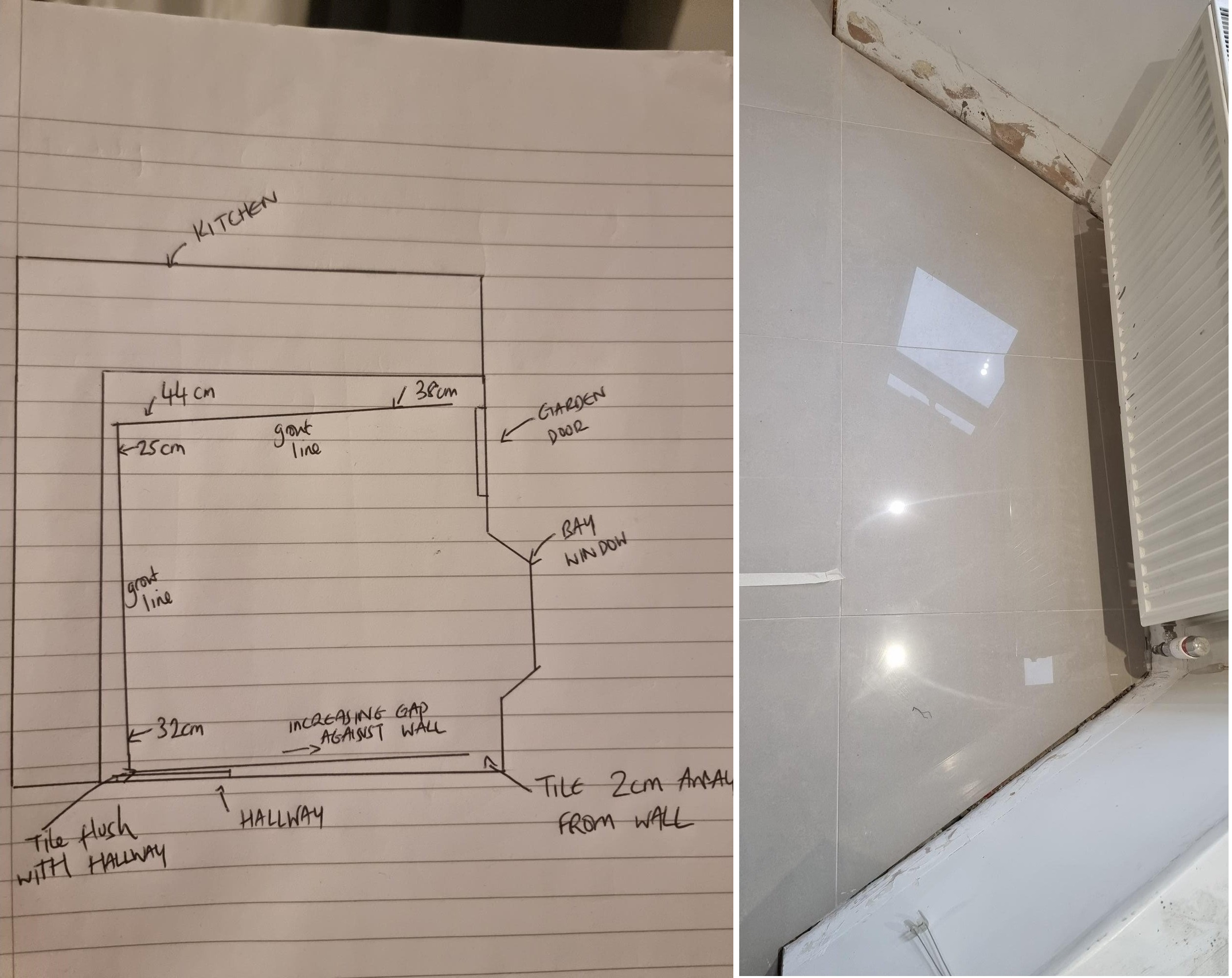We’d like to remind Forumites to please avoid political debate on the Forum.
This is to keep it a safe and useful space for MoneySaving discussions. Threads that are – or become – political in nature may be removed in line with the Forum’s rules. Thank you for your understanding.
📨 Have you signed up to the Forum's new Email Digest yet? Get a selection of trending threads sent straight to your inbox daily, weekly or monthly!
Tiling Job - Tiles not straight
Comments
-
Section62 said:Jeepers, I don't want this to become another protracted 'discussion', but this point you've made is simply wrong. It is there in black and white on the Jack's sketch.
The difference along the hallway wall is 20mm. The difference along the units opposite (the one with the sink) is 60mm.
Rotating the tiles to close the 20mm gap won't close the 60mm gap. Rotating them to close the 60mm gap would more than close the 20mm gap. There needs to be a choice (or else a compromise) between the two.
We also can't comment on the gap with the units where the hob is, or the bay window, because the room is rectangular and not square-shaped. The aspect ratio of the tiled area is not 1:1. Therefore whether the required rotation angle to align the tiles with the hob units is the same as the one on the other sides is not known without Jack doing further measurements.
For Jack's sake that point is really important - and hopefully we can find a way to agree. Otherwise if he bases his claim on it being possible for the tiler to do a near-perfect job on all 4 sides then all the tiler has to do is use Jack's own figures to show that was in fact impossible.
If I'm wrong, and you have a rotation method that would close both the 20mm gap and the 60mm (to something close to perfectly), then I would ask genuinely, please explain it to me. Because after years of using CAD and trigonometry in surveying and engineering design it isn't a method I can see.Absolutely, S62.I hope I've made it clear that it's based on what Jack has shown us.This in particular: The grout line-to-LH wall (units) is out by approx 7cm, and the grout line-to-end wall (units) by around 6cm, and this is in the same direction. Ie, straighten one and you ditto the other. These appear to be incredibly consistent 'squints', especially when you consider that the end wall is also slightly shorter. 'Rotate' the tiles and you've sorted it.The grout line within the bay window also appears to be 'out' by a not-dissimilar margin - 5-odd cm? - which, again, is very consistent and would also be largely sorted with the same rotation. And the original tile layout was 'straight' across this bay opening, which is what it would be closely be with the same amount of rotation.The only wall which is 'different' is the entrance wall which only appears to be 'out' by around 2cm along its length, but - fortuitously - this is the least important wall as it's the least visible. If the grout line were kept away from that wall, the remaining variation could be largely lost within the tile size.Based on the info provided, the tiler has surely just messed up big time? And that's all that's happened here - an initial layout error, for which the tiler is 100% responsible.(Oops - NSG - the troublemaker - has already said this :-) )
The grout line-to-LH wall (units) is out by approx 7cm, and the grout line-to-end wall (units) by around 6cm, and this is in the same direction. Ie, straighten one and you ditto the other. These appear to be incredibly consistent 'squints', especially when you consider that the end wall is also slightly shorter. 'Rotate' the tiles and you've sorted it.The grout line within the bay window also appears to be 'out' by a not-dissimilar margin - 5-odd cm? - which, again, is very consistent and would also be largely sorted with the same rotation. And the original tile layout was 'straight' across this bay opening, which is what it would be closely be with the same amount of rotation.The only wall which is 'different' is the entrance wall which only appears to be 'out' by around 2cm along its length, but - fortuitously - this is the least important wall as it's the least visible. If the grout line were kept away from that wall, the remaining variation could be largely lost within the tile size.Based on the info provided, the tiler has surely just messed up big time? And that's all that's happened here - an initial layout error, for which the tiler is 100% responsible.(Oops - NSG - the troublemaker - has already said this :-) )
2 -
koalakoala said:It’s just a pity you didn’t look at the tiling before he finished. Did he leave it overnight before grouting?
I don't think the presence of grout is the main issue
0 -
No, but you often leave tiles overnight before grouting because the adhesive hasn't completely set. The lines would be more visible than they are grouted. A two day job...Jeepers_Creepers said:koalakoala said:It’s just a pity you didn’t look at the tiling before he finished. Did he leave it overnight before grouting?
I don't think the presence of grout is the main issue
The question is really whether a judge would look at the work and make a decision that the tiler was responsible for all the work to be completely redone and for the materials on a labour-only contract. It is fit for purpose, it just isn't straight.
I don't have an answer.Everything that is supposed to be in heaven is already here on earth.
4 -
A professional tiler just wouldn't have done that. The pictures looked fine but the illustration shows the difference between someone who's been in the trade for years after proper training and someone who's having a go and get it to look good. Even I know the starting point is key here!Doozergirl said:
No, but you often leave tiles overnight before grouting because the adhesive hasn't completely set. The lines would be more visible than they are grouted. A two day job...Jeepers_Creepers said:koalakoala said:It’s just a pity you didn’t look at the tiling before he finished. Did he leave it overnight before grouting?
I don't think the presence of grout is the main issue
The question is really whether a judge would look at the work and make a decision that the tiler was responsible for all the work to be completely redone and for the materials on a labour-only contract. It is fit for purpose, it just isn't straight.
I don't have an answer.
OP - what's this chap's credentials? On what basis did you hire him, recommendation or having seen his work?No man is worth crawling on this earth.
So much to read, so little time.0 -
I have read this thread over several days and whilst I’m not going back to read it all again, I think there was a comment at the start that the tiler required to be paid partly up front for materials. That alone would have had me running for the hills as I don’t think that any good trades people should need to have their materials funded in advance - they should have credit accounts with suppliers. If they don’t, that says a lot about them and perhaps it’s not quite as surprising in that context that this mistake has happened. Just my two cents and of course, I accept that none of this is helpful given it’s all in the past. But it might be helpful in future.Northern Ireland club member No 382 :j0
-
Jack. Further to my suggestion that you post on the Consumer Advice you might also want to think about the timeline of events.
Were you on site when the tiler arrived and did you have any discussions regarding the layout?
Did you look at the progress at all or were you not able to for some reason e.g. you were out at work and he finished in one day?
Just trying to think of things that may be asked of you if it goes legal as they might investigate whether you had any opportunity to mitigate your losses.
It would also be useful to see your drawing with the bay window wall dimensions added too.
Sorry I can't think of anything profound, clever or witty to write here.2 -
Rosa_Damascena said:OP - what's this chap's credentials? On what basis did you hire him, recommendation or having seen his work?"We went for a very reputable and highly reviewed tiler to do our tiling work..."The quote was seemingly £2,100 including materials but not the actual tiles - Jack paid £500 for these separately.What did this quote include, Jack? How much other work did the tiler do before laying the tiles?0
-
Section62 said:
Jeepers, I don't want this to become another protracted 'discussion', but this point you've made is simply wrong. It is there in black and white on the Jack's sketch.Jeepers_Creepers said:...but has managed - incredibly - to get all 4 sides wrong, by a not dissimilar amount on all 4 walls.
Ie, had he laid out the tiles with a roughly two degree(?) clockwise rotation to his poorly-chosen line, the tiles would have sat nigh-on perfectly with all 4 sides.
The difference along the hallway wall is 20mm. The difference along the units opposite (the one with the sink) is 60mm.
Rotating the tiles to close the 20mm gap won't close the 60mm gap. Rotating them to close the 60mm gap would more than close the 20mm gap. There needs to be a choice (or else a compromise) between the two.
We also can't comment on the gap with the units where the hob is, or the bay window, because the room is rectangular and not square-shaped. The aspect ratio of the tiled area is not 1:1. Therefore whether the required rotation angle to align the tiles with the hob units is the same as the one on the other sides is not known without Jack doing further measurements.
For Jack's sake that point is really important - and hopefully we can find a way to agree. Otherwise if he bases his claim on it being possible for the tiler to do a near-perfect job on all 4 sides then all the tiler has to do is use Jack's own figures to show that was in fact impossible.
If I'm wrong, and you have a rotation method that would close both the 20mm gap and the 60mm (to something close to perfectly), then I would ask genuinely, please explain it to me. Because after years of using CAD and trigonometry in surveying and engineering design it isn't a method I can see.Hi Section62. Thank you for your comment. I feel I haven't added a level of detail where I should have done so let me explain further. When I say the tiles would have lined up perfectly, I don't actually mean 'perfectly' on every wall. Had the tiler tiled parallel to the units, the top edge of the kitchen, the left hand side of the kitchen, and the wooden hallway would have lined up picture perfectly. Flush is the word.These are the only areas that you would be able to see and therefore notice a misalignment when walking into and around the kitchen. The bay window area will have a dining table covering it and the rear wall, a fridge. All of this was explained to the tiler beforehand so that he didn't add underfloor heating cabling under the area where the fridge would be for example. This would be where you would want to hide any discrepancies. Again, I thought it would be obvious that the tiles should line up to the units in a large 16m2 kitchen.Now let's just assume that those 2 area areas are not to be covered to hide any discrepancies, had the tiler tiled parallel against the units, the deviation/discrepancy in these area would have been small that it would not have been discernible.For example, right now, the edge to edge grout line in the bay window has a different of 10.5cm. Had the tiler followed the units, the actual difference would have been around 1.5cm. So yes, you are right, the tiles would not line up 'perfectly' on all 4 walls but I posit that it's near impossible to find any room where all 4 walls are perfectly aligned. The point here is that there has to be a reference point to minimize and mitigate the imperfect dimensions of the room. Like I've said, the previous tilers had figured this out and they had the hallway, left hand side and top end of the kitchen perfectly aligned. The tiles were flush. The bay window size and the rear side were not 'perfectly' flush but they were good enough to make any deviation indiscernible unless you actually took out a ruler to figure it out.I can get perfect measurements and make a scale drawing today for those interested, but I feel like I've made my point clear.When we bought the house, there was no question at all of the tile layout whatsoever because the tiles were parallel to the units and the hallway. The other 2 sides were not flush but the deviation is so small, it wasn't noticeable.What we've ended up with now is wonky tiles against EVERY single edge of my walls and the wood lines in my wooden hallway. Surely having the kitchen unit walls perfectly lined up, the hallway lined up (with the wooden flooring lines) and having a near indiscernible difference on the other 2 remaining walls was the obvious way to go. I'm no tiler and I've managed to figure it out. So did the previous tilers. I don't see how it should have been done any other way. The fact that the tiler is failing to highlight his reference point is a testament to that.I'm just working atm but I'll try and get a scale drawing made tonight4 -
Jack_Bauer said:Hi Section62. Thank you for your comment. I feel I haven't added a level of detail where I should have done so let me explain further. When I say the tiles would have lined up perfectly, I don't actually mean 'perfectly' on every wall. Had the tiler tiled parallel to the units, the top edge of the kitchen, the left hand side of the kitchen, and the wooden hallway would have lined up picture perfectly. Flush is the word.
Jack, this is a useful comment and sums up the conversation Jeepers and I have been having. In building and construction 'perfect' doesn't exist, every task is carried out with a degree of tolerance - either explicitly specified, or as a 'norm' for that task. Most of the time it isn't even discussed, it is assumed. And if a dispute ends up in court the judge will decide what is and isn't a reasonable assumption.
It wasn't clear to me what you were expecting, and from your first post in this thread it appeared you were unhappy with the 20mm along the hallway wall. I had have concerns that some comments risked creating an unrealistic expectation that you could get another tiler to come in and rip up what has been done and redo it with (say) sub-20mm differences along all 4 sides. You could spend money doing that, and then still be unhappy with the result.
The reason for that can be seen in NSG666's post yesterday evening. Based on the figures you've given us, aligning the tiles with the longer run of units could mean a ~50mm difference along the hallway wall. 50mm is obviously a lot more than the current 20mm, and I'm not sure this is what you have in mind when you mention 'picture perfectly'. Are you only concerned about the area around the hallway doorway, or along the whole length of that wall?It is also important and relevant that you explained to the tiler beforehand about the table and fridge with an awareness of how these will impact on the visibility of differences in the bay window area and the rear wall. The bay window area is clearly the least 'correct'. Did you explicitly tell him that you wanted any differences to be in that area?
Also, it would be useful if you can confirm whether this is the same tiler who started the project in February, and whether any of the outstanding money relates to work done in lifting the old tiles and cleaning up the floor.
If you are going to make or defend a claim you will need to have an accurate scaled drawing with all important dimensions shown. The advantage of doing this now is it will clarify for you (and us) that the measurements are right, the amount of 'error' the tiler has made, and whether there is a solution which would be 'perfect' for you.Jack_Bauer said:I can get perfect measurements and make a scale drawing today for those interested, but I feel like I've made my point clear.
If you do get the floor redone you can give whichever tiler a copy of your final plan and tell them you want it done exactly that way.
In this case the best way of producing an accurate plan is to start by drawing a grid representing the central 7 x 4 'block' of whole tiles, rather than starting with the walls or units. Do some check measurements to confirm the size of that block, instead of assuming each tile is 600x600.
Once you have confirmed that 7 x 4 tile block you have a shape which you know is 'square' (in terms of the angles). You can then plot the walls and the units by measuring along the grout lines to each intersection with the wall/units. Bear in mind the walls might curve as well as not being aligned so take as many grout-line offset measurements as you think necessary to accurately represent the wall. Also bear in mind that without skirting boards there may be voids which mean what you measure isn't the true face of the wall - so use a straight edge to project the true face down to the tiles if necessary. Likewise, use a straight edge across the front of the units to accurately measure the offset to them.
And use mm for measuring and dimensioning rather than cm. The rounding error when comparing two measurements quoted in whole cm could be as much as 10mm.
All of the above could be regarded as being pedantic. But if you end up arguing with the tiler over differences of about +/-30mm then introducing an error of (say) 10mm in your own measurements is going to be important, and it could harm the credibility of your (legal) claim if you've got it wrong. Very accurate measurements aren't usually required for normal work, but you are now in dispute, so your accuracy needs to be as good as or better than his. And remember, he has a laser. 0
0 -
The best tilers I've ever seen were some Italian lads when working in Germany many years ago. They said that most of them started their apprenticeships at 14. Really fast workers, but top quality work.1
Confirm your email address to Create Threads and Reply

Categories
- All Categories
- 352.8K Banking & Borrowing
- 253.9K Reduce Debt & Boost Income
- 454.7K Spending & Discounts
- 245.9K Work, Benefits & Business
- 602K Mortgages, Homes & Bills
- 177.8K Life & Family
- 259.8K Travel & Transport
- 1.5M Hobbies & Leisure
- 16K Discuss & Feedback
- 37.7K Read-Only Boards








